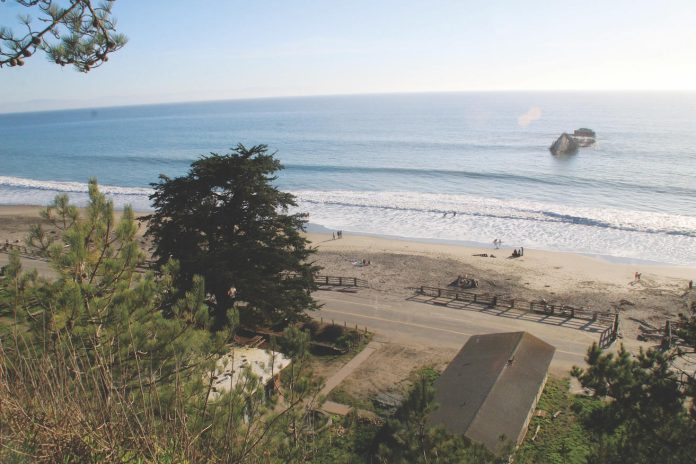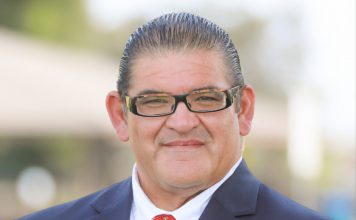In the past, visitors at Seacliff State Beach could gaze upon the S.S. Palo Alto, the famed Concrete Ship at the end of the equally famous wharf.
Relentless waves and occasional storms over time have destroyed the wharf, and the ship remains a local landmark despite being pounded into little more than a pile of rubble.
But one thing has not changed: the spectacular view from the high cliffs that gives visitors an unobstructed view across the ocean to Monterey, about 30 miles to the south.
That could change after the Trump Administration on Nov 20 announced plans to drill for oil along the west coast—including all along California.
It is not yet clear where the oil rigs would be placed. But the idea has many worried they will become an eyesore and a possible source of pollution.
The nonprofit Save Our Shores has voiced strong opposition to the plan, saying it “places West Coast communities, economies, and coastal ecosystems at unacceptable risk.”
The U.S. Department of the Interior’s newly released Five-Year Offshore Drilling Plan (5YP), targets California waters for the first new oil and gas lease sales in four decades, Save Our Shores stated in a press release.
The plan outlines six proposed lease sales off California between 2027 and 2030, two of which are off the Central Coast.
“California has learned painful lessons from past spills, and our communities should never again be forced to bear the consequences of decisions made far from our coastline,” said Save Our Shores Executive Director Katie Thompson. “This plan is reckless, unnecessary, and completely out of step with what Californians want. We’re committed to doing everything in our power to defend our coast and the people who depend on it.”
The Department of the Interior said the 11th National Outer Continental Shelf Oil and Gas Leasing Program—planned to be launched by October 2026—reflects the administration’s commitment to “restoring American energy dominance.”
In a press release, Secretary of the Interior Doug Burgum said that the Biden administration “slammed the brakes” on offshore oil and gas leasing.
“By moving forward with the development of a robust, forward-thinking leasing plan, we are ensuring that America’s offshore industry stays strong, our workers stay employed, and our nation remains energy dominant for decades to come,” Burgum said.
Save Our Shores says that expanding offshore drilling puts the state’s coastal regions at risk of oil leaks and spills, which could shut down beaches, harm wildlife, disrupt tribal cultural practices, halt fishing operations and devastate local businesses that rely on the beaches.
“It is sickening to learn that the Trump administration has relaunched the outer continental shelf oil and gas leasing program, but not surprising,” said Santa Cruz County Supervisor Justin Cummings. “This is why we have been building a local government coalition to fight back against these efforts, and fight back we will.”
Supervisor Kim De Serpa agreed.
“We are standing shoulder to shoulder to fight against the administration’s plan to drill for oil off the entire coast of California,” she said. “I feel certain that supervisors in Central Coast counties and throughout California will stand together to protect our coastal waters, support our state and federal representatives, and stop this action. We continue to insist on protection of our coastlines and waters, our tourism industry and fisheries, and our marine mammals and all creatures in our Pacific Ocean.”
Save Our Shores points out that the state’s major industries—tourism, recreation, shipping, research, sustainable fisheries, and marine- dependent small businesses—all are at risk from the plans.
In response, the organization has reinvigorated the “Blue Wall,” a network of local zoning protections that restrict or require voter approval for onshore infrastructure tied to offshore drilling.
This strategy, first developed in the 1980s, empowered coastal communities to prevent the onshore facilities that offshore oil operations require.
Current actions include:
• Partnering with cities and counties to update existing ordinances and incorporate
protections against supporting infrastructure for both offshore oil and seabed mining.
• Supporting statewide coordination through renewed local government efforts to oppose new federal offshore leasing.
• Expanding the Blue Wall to regions that did not previously face offshore development pressure but are newly included in federal plans.
“Local governments helped stop offshore drilling once before, and they can do it again,” Thompson said. “We’re building on decades of successful grassroots leadership to ensure California’s coast remains protected for future generations.”
Call for Public Action
Save Our Shores is urging residents to participate in the upcoming federal public comment period, which opened on Nov. 24, and will last through Jan. 23, 2026.
There are two ways to oppose the plan.
• Visit Regulations.gov, and refer to Docket ID: BOEM-2025-0483 to submit comments.
• Write to Ms. Kelly Hammerle, Bureau of Ocean Energy Management (VAM-LD), 45600 Woodland Road, Sterling, VA 20166-9216.
Label the envelope “Comments for the 11th National OCS Oil
and Gas Leasing Program.”














How could anybody put oil rigs off the Monterey Bay. I can remember and see clearly in my mind thousands and thousands of seabirds of all varieties, The fish were in the millions also. It’s all gone now, there’s a few birds and a few fish left, that’s it. An oil spill would be devastating to what’s left. First thing you will say though is ” with today’s technology and safety record a spill is next to impossible.” Sure.
Trump regime is killing all kinds of protections for wildlife, endangered species and protections for our precious wetlands. Also, ending EPA protections for our land and air and they have approved more horrible forever chemicals to be used in farming and that will put everyone’s health in danger. Why vote for the GOP with their awful and dangerous plans to enrich the already rich with more and cut their taxes while the national debt grows higher. Trump adm has already added 3 more trillion to the debt with no end in sight.